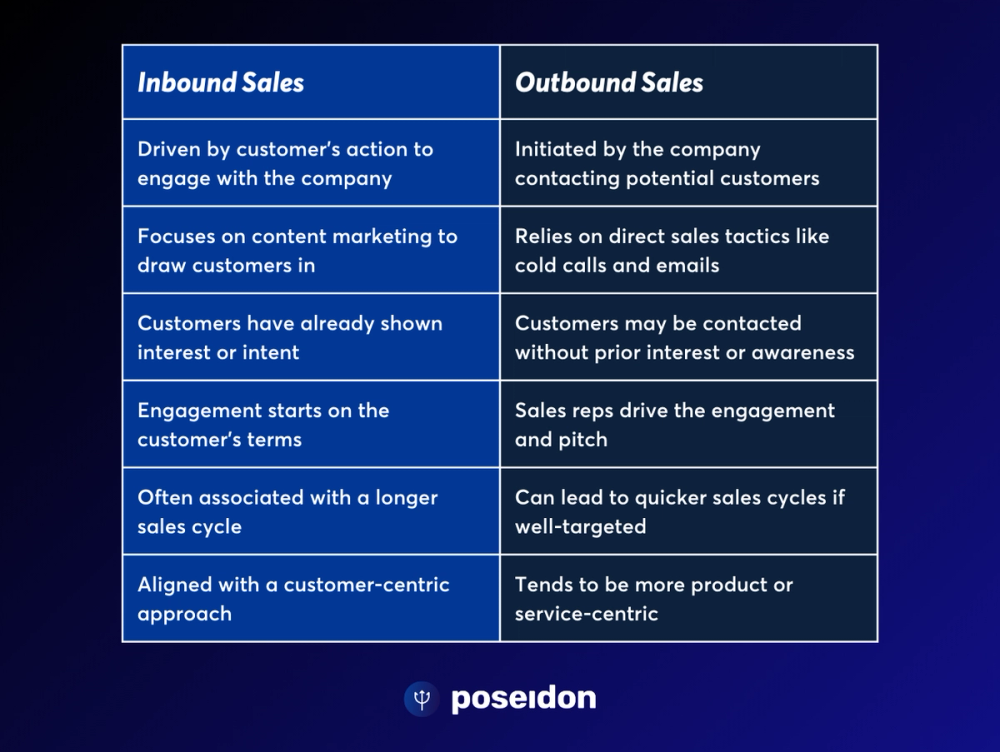Navigating the competitive landscape of outbound sales can leave many businesses struggling to make their mark.
A staggering 40% of salespeople say prospecting, a key outbound sales tactic, is the most challenging part of the sales process, according to HubSpot, highlighting the need for improved outbound prospecting techniques.
This article will illuminate practical strategies and best practices vital for enhancing your outbound efforts and turning prospects into profits.
Dive in to transform your approach and unlock new levels of success!
Let's Understand Outbound Sales
Outbound sales technique involves reaching out to potential customers proactively, rather than waiting for them to come to you. This can include cold calls, email outreach, and social media engagement.
Different types of outbound sales reps may specialize in different methods of communication and engagement with leads.
Definition
Outbound sales refer to the traditional approach where sales reps initiate customer engagement by reaching out to potential clients.
Unlike inbound sales, which relies on drawing customers in through content marketing and SEO strategies, outbound efforts actively push a company's message outward.
Sales professionals use various methods such as cold calling, email marketing campaigns, and social media outreach to connect with targets groups that might benefit from their products or services.
This strategy involves targeting specific market segments with tailored messages that showcase a value proposition designed to pique interest and prompt further sales conversation. Effective outbound sales require meticulous planning, refined communication skills, and robust knowledge of the product being sold.
Differences between outbound and inbound sales
Understanding the contrast between inbound and outbound sales is pivotal for crafting effective strategies and achieving sales goals.
Inbound sales revolve around strategies that attract customers and make them initiate contact with your business, typically through marketing efforts that encourage them to reach out for more information, a demonstration, or a purchase.
Conversely, outbound sales involve proactive outreach to potential customers, often through cold calling or emailing, with sales reps initiating contact.

Having delved into these differences, addressing the challenges and harnessing the benefits of outbound sales becomes our next focus.
Types of Outbound Sales Reps
Outbound sales reps are the driving force behind a company's direct selling efforts. They use various tactics to reach potential customers and drive sales.
Sales Development Reps (SDRs):
These reps focus on initiating contact with prospects through cold calls or emails. Their main goal is establishing connections and qualifying leads before passing them to account executives, which is essential for outbound sales success.
Business Development Reps (BDRs):
BDRs operate similarly to SDRs but often work on nurturing longer-term relationships. They focus on identifying strategic opportunities for business growth, often through partnerships or new market segments.
Account Executives:
Once a lead is qualified, account executives take over. They are responsible for negotiating deals and closing sales. Their in-depth product knowledge and ability to build rapport with clients are vital for converting prospects into customers.
Customer Success Reps:
Post-sale, these reps ensure customer satisfaction which could lead to upselling or cross-selling opportunities. They maintain the relationship and may handle renewals or follow-up sales.
Challenges of Outbound Sales Process
Identifying the target audience, generating leads, and conducting effective sales calls and demos are key challenges in outbound sales. Overcoming these obstacles requires strategic planning, effective communication, and a deep understanding of customer needs.
Identifying target audience
Identifying your target audience is a crucial step in outbound sales. Understanding the demographics, behaviors, and preferences of your ideal customers enables you to tailor your outreach and messaging effectively for outbound sales success.
Utilize key demographic information such as age, gender, location, and income level to refine your targeting efforts.
Analyzing the pain points and challenges faced by your target audience allows you to position your product or service as a solution to their specific needs. This insight provides valuable guidance for crafting compelling sales pitches that resonate with potential customers on a deeper level.
Lead generation
Having identified your target audience, the next crucial step in outbound sales is lead generation. This involves actively seeking out potential customers who have demonstrated an interest in your product or service.
Utilize various strategies, such as content marketing to attract prospects to your website, engaging with potential leads on social media platforms, and leveraging networking events to build connections.
Embracing a multi-faceted approach that combines digital and traditional methods will maximize the chances of generating high-quality leads for your outbound sales efforts.
To boost lead generation, it's essential to optimize your online presence through search engine optimization (SEO) techniques and well-crafted landing pages that entice visitors to provide their contact information.
Sales calls and demos
Sales calls and demos are essential components of outbound sales strategies. When reaching out to potential customers, sales reps must effectively communicate the value proposition of their product or service.
This involves utilizing persuasive language, active listening, and addressing any concerns or objections the prospect may have. Additionally, conducting engaging and informative product demonstrations can significantly impact a prospect's decision-making process.
Furthermore, leveraging technology for virtual demos and screen sharing can enhance the overall experience for prospects, an effective outbound sales tactic.
Capturing their attention through compelling presentations is crucial in moving them along the sales pipeline towards conversion, a hallmark of effective outbound prospecting.
Using keywords relevant to the customer's pain points during these interactions can create a more personalized and impactful engagement, making it easier for them to see how your offering meets their needs.
Effective Outbound Sales Strategies
Scale operations through hiring and expansion, utilize technology for optimization, and engage with potential customers across multiple channels to increase outreach. To learn more about these effective strategies in outbound sales, keep reading!
Scale operations through hiring and expansion
To scale operations through hiring and expansion, companies can consider the following strategies:
- Identify the core competencies required: Understand the specific skills and expertise needed for growth, such as sales experience, industry knowledge, or technical proficiency.
- Develop a recruitment process: Create a well-defined process for sourcing, interviewing, and onboarding new team members to ensure a smooth integration into the existing sales structure.
- Invest in training and development: Provide comprehensive training programs to equip new hires with product knowledge, sales techniques, and communication skills tailored to the company's unique selling proposition.
- Foster a supportive culture: Cultivate an environment that encourages collaboration, continuous learning, and teamwork to maximize productivity and employee satisfaction.
- Leverage technology for efficiency: Implement sales management platforms or customer relationship management (CRM) systems to streamline processes and facilitate seamless communication within the expanded team.
Utilize technology for optimization
To streamline outbound sales operations, embracing technology is crucial for optimization. Implementing a robust CRM software such as Salesforce or HubSpot can centralize lead data, track interactions, and automate routine tasks like follow-up emails.
Furthermore, leveraging sales enablement tools like Poseidon or SalesLoft can enhance outreach efficiency through personalized templates and automated sequencing. Integrating customer engagement platforms like Intercom or Drift enables real-time communication with prospects, fostering stronger relationships and quicker conversions.
Overall, investing in the right technology empowers outbound sales teams to work smarter, not harder – maximizing productivity and outbound sales success.
In addition to streamlining processes, adopting analytical tools such as Google Analytics or Kissmetrics provides invaluable insights into campaign performance and customer behavior.
Utilize multiple channels for engagement
To optimize your outbound sales efforts, utilizing multiple channels for engagement can significantly enhance your reach and impact.
This multifaceted approach allows you to connect with prospects through various touchpoints, increasing the likelihood of meaningful interactions and conversions.
5 Best Practices for Outbound Sales
In order to excel in outbound sales, it is crucial to focus on customer needs and personalize outreach. Asking for referrals and utilizing scripts and automation can also enhance the effectiveness of your sales efforts.
Lastly, implementing key performance indicators will help measure success and drive continuous improvement in your outbound sales strategies.
1. Focus on customer needs
Understanding and addressing the specific needs of customers is crucial in outbound sales. Tailoring outreach efforts to align with their pain points and desires fosters a deeper connection and increases the likelihood of conversion.
Sales representatives can adjust their approach and enhance customer satisfaction by attentively listening to feedback from customers, leading to the development of strong, lasting relationships.
Personalizing communication based on customer needs builds trust, strengthens brand loyalty, and ultimately drives growth. This approach also allows for more effective problem-solving and value delivery, creating mutually beneficial outcomes for both the business and its customers, which is vital for outbound sales success.
To excel in outbound sales, it's essential to place a relentless focus on understanding and meeting customer needs.
2. Ask for referrals
To expand your network and reach potential customers, it's crucial to seek out referrals from existing satisfied clients. Referrals are an effective way to leverage your current customer base, tapping into their networks for warm introductions.
You can gain access to leads that are already pre-qualified, thus saving time and effort in the prospecting process. Implement a systematic approach to requesting referrals by integrating it into your sales process and setting clear expectations with your customers.
Capitalize on the trust established with existing clients to facilitate introductions to decision-makers within their professional circles.
3. Personalize outreach
Personalize your outreach efforts to connect with potential customers on a deeper level. Tailoring your messaging and communication to address the specific needs and pain points of each prospect can significantly increase engagement and response rates, a core principle in successful outbound sales tactics.
By demonstrating an understanding of their unique challenges and offering personalized solutions, you can build trust and rapport, ultimately leading to more successful conversions.
Utilize customer data and insights to craft customized messages that resonate with the individual recipient, tapping into strategies to increase the effectiveness of outbound sales. This approach shows that you value their business as more than just a transaction, making them more likely to engage with your outreach efforts.
4. Utilize scripts and automation
Scripts and automation can streamline your outbound sales process, saving time and ensuring consistent messaging. By using pre-written scripts, sales reps can maintain professionalism while delivering a personalized touch to each interaction.
Automation tools also help in managing follow-ups, scheduling calls, and tracking customer engagement across multiple channels.
With the right scripts and automation in place, sales teams can efficiently handle a large volume of outreach while still providing individualized attention to leads. By automating repetitive tasks like data entry or email follow-ups, your team can focus on building relationships with potential clients and closing deals effectively.
5. Key performance indicators for measuring success
Utilizing scripts and automation in outbound sales paves the way for robust performance tracking. To gauge the success of outbound strategies, it's crucial to monitor Key Performance Indicators (KPIs). Below is a table outlining essential KPIs for outbound sales success:
Below is a list of outlining essential KPIs for outbound sales success:
- Conversion Rate
- Call-to-Connection Ratio
- Response Rate
- Average Deal Size
- Lead Response Time
- Sales Cycle Length
- Revenue Per Call
- Customer Acquisition Cost (CAC)
- Customer Lifetime Value (CLV)
Tracking these KPIs helps sales teams refine their strategies and achieve optimal performance in outbound sales endeavors.
Conclusion
In conclusion, implementing effective outbound sales strategies is crucial for driving success in today's competitive market. By focusing on customer needs, personalizing outreach efforts, and using scripts and automation to streamline processes, businesses can achieve higher conversion rates and stronger relationships with their clients.
Key performance indicators play a vital role in measuring success and guiding ongoing improvements. Embracing these best practices will enable companies to navigate the challenges of outbound sales while maximizing their ROI and achieving sustainable growth.
FAQs
1. What is the role of cold emailing in outbound sales strategies?
Cold emailing serves as a direct approach to generating new sales leads by reaching out to potential customers who have not yet expressed interest in a product or service.
2. How does social selling enhance B2B sales efforts?
Social selling leverages social networks and tools like LinkedIn to engage with target audiences, fostering relationships that can lead to increased sales opportunities in business-to-business contexts.
3. Can CRMs improve the efficiency of my sales funnel?
Yes, implementing Sales CRM systems allows for meticulous tracking and management of customer interactions within your sales funnel, improving lead nurturing and leading to more successful conversions.
4. What benchmarks should I consider for evaluating the success of outbound marketing campaigns?
Important benchmarks include click-through rate, cost per opportunity, calls to close ratio, and long-term value (LTV) metrics which help determine the return on investment (ROI) from various strategies such as online ads or account-based marketing.
5. Why are voicemails still relevant in today's digital age for outbound sales?
Voicemails remain an essential tool because they provide a personal touchpoint that can differentiate you from competitors when prospecting or following up with clients; it’s also a way to reach prospects who may prefer voice communication over email or text messages.
6. What best practices should be adopted when creating effective calls to action for emails sent through Gmail or other platforms like Shopify?
Create concise and compelling calls to action that clearly instruct recipients on what steps they need take next—whether subscribing, learning more about your offer, or directly engaging with negotiations—and ensure these align closely with their needs and interests.




![Best LinkedIn Sales Strategy In 2025 [+Templates]](https://cdn.sanity.io/images/l79olr63/production/f506b7ad35e15d3d5fcdb46ee807bbda7f5df908-1232x928.webp)
